Why & How to Start Rooftop Farming
Product News food security, urban farmingRooftop farming can trace its roots back to ancient Mesopotamia. What had possibly started as an attempt at self-sufficiency, slowly picked up the pace for myriad reasons, from beautification to the setting up of a tranquil, quiet corner atop one’s home. Today, apartment complexes and gated communities have once again taken the lead in rooftop farming, utilising limited urban spaces in an innovative manner while creating a pleasing environment for residents.
What is rooftop farming?
Rooftop farms or gardens are manmade green spaces atop industrial, commercial, or residential buildings. While a rooftop farm is meant for farming produce, it can also include rooftop gardens which are mostly conceived for decorative or leisure purposes.
Benefits of rooftop farming
Besides their decorative effect, rooftop farms or gardens have many other benefits, including:
Food for residents: Depending on the availability of space, rooftop farms can be used to grow almost any kind of food, particularly vegetables, fruits, and herbs. With complete control over farming practices, residents can use the rooftop to drive campaigns like organic farming or permaculture.
Temperature control: Temperature control is a major concern in many of our urban areas. Bare rooftops absorb and radiate heat, becoming part of urban heat islands. These are areas where high human activity raises the temperature. In contrast, rooftop gardens absorb the heat, reducing ambient temperature while improving the air quality. On a large scale, rooftop gardens can have a significant impact in reducing heat islands and improving the air quality in urban areas.
Recreational: Studies have shown that green spaces can improve mental health, boosting attention, creativity, and memory. Rooftop gardens make ideal recreational spaces for all residents. In the case of a rooftop farm, it can also be a strong binding factor for community building.
Reducing rain run-off: Thanks to insufficient urban waste infrastructure, rainwater run-off often becomes a worrisome issue during heavy rains. Rooftop gardens can reduce peak runoff by forming a retention basin where plants hold the excess rainfall.
How to start your rooftop garden?
To start a rooftop garden, the key steps are to prepare the roof, select the right plants, create a watering and drainage system, and install wind breaks if needed.
Preparing the roof
Start by checking the building codes to gauge how much weight the roof can safely handle. Pick a durable area that can withstand the weight of planters or soil beds. You can use large and small planters, create raised beds, or cover the roof with planting soil like any garden. In case you decide to go with creating beds, start with waterproofing and insulating the roof.
While most modern buildings have waterproofing, it is still advisable to apply a waterproof layer like plastic sheets, bitumen roofing, concrete admixture, or a polymer coating. Make sure it is root and rot-resistant. You can also opt for an insulation or protection layer made of polyurethane foam, XPS extruded polystyrene boards, PIR panels, polystyrene cement, foamed concrete, or autoclaved aerated concrete. The protection layer is also important for drainage.
Select the right plants
The plants should be selected as per the air and wind exposure on the roof. Different areas of the roof will have different sun exposure. So, it’s best to gauge the sun’s movement over the roof throughout the day. Take note of areas that are always under a shade, such as the area next to a wall. Whether growing ornamental plants or food crops, pick your plants as per their need for sunlight. Given the limitation of maintaining a specific soil depth, it’s also important to pick plants with shallow roots. You can choose large planters for plants with deep roots, but keep the overall weight in mind. If the roof has high wind exposure, you may have to build some kind of wind barrier.
Preparing the soil
It’s best to opt for well-draining, lightweight, and aerated soil that is rich in organic matter.
Drainage and irrigation
Water management, both in terms of irrigation and drainage is critical when it comes to roof gardens. Roof farming usually has a very high water requirement because of high sun exposure. At the same time, efficient drainage is critical to ensure that water does not pool anywhere. Manually watering the roof can work, provided it is carried out regularly but not in excess. Drip irrigation and sprinklers are good options. For drainage, you can use plastic drainage models, porous mats, granular material, or a water storage reservoir.
Now that you have the basics of rooftop farming, you can start creating green spaces in residential complexes. Apart from working towards food security, these spaces can be critical places for members of the community to meet, relax, and connect with nature and each other.
